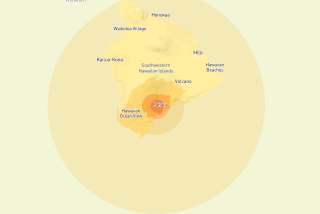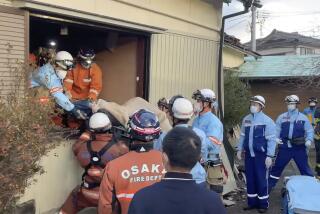Tsunami swamps Hawaii beaches
Tsunami waves swamped Hawaii beaches and brushed the U.S. western coast Friday but didn’t immediately cause major damage after devastating Japan and sparking evacuations throughout the Pacific.
Water rushed up on roadways and into hotel lobbies on the Big Island and low-lying areas in Maui were flooded as 7-foot waves crashed ashore. Smaller waves hit the U.S. western coast and beaches were closed as fishermen fired up their boats and left harbors to ride out the swell.
Photos: Scenes from the earthquake
Scientists warned that the first tsunami waves are not always the strongest, and officials said people in Hawaii and along the West Coast should watch for strong currents and heed calls for evacuations. The tsunami warning was downgraded to an advisory in Hawaii, but officials said people should still stay away from beaches.
“I’m waiting to see if I’ll be working and if I can get to work,” said Sabrina Skiles, who spent the night at her husband’s office in downtown Kahului in Maui. Their home, across the street from the beach, was in a mandatory evacuation zone. “They’re saying the worst is over right now but we keep hearing reports saying ‘don’t go anywhere. You don’t want to go too soon.’”
The tsunami, spawned by an 8.9-magnitude earthquake in Japan, slammed the eastern coast of Japan, sweeping away boats, cars, homes and people as widespread fires burned out of control. It raced across the Pacific at 500 mph - as fast as a jetliner - before hitting Hawaii and the West Coast.
Sirens sounded for hours before dawn up and down the West Coast and in Hawaii, and roadways and beaches were mostly empty as the tsunami struck.
President Barack Obama said the Federal Emergency Management Agency is ready to come to the aid of any U.S. states or territories who need help. Coast Guard cutter and aircraft crews were positioning themselves to be ready to conduct response and survey missions as soon as conditions allow.
It is the second time in a little over a year that Hawaii and the U.S. West coast faced the threat of a massive tsunami. A magnitude-8.8 earthquake in Chile spawned warnings on Feb. 27, 2010, but the waves were much smaller than predicted and did little damage.
Scientists then acknowledged they overstated the threat but defended their actions, saying they took the proper steps and learned the lessons of the 2004 Indonesian tsunami that killed thousands of people who didn’t get enough warning.
This time around, the warning went out within 10 minutes of the earthquake in Japan, said Gerard Fryer, a geophysicist for the Pacific Tsunami Warning Center in Honolulu.
“We called this right. This evacuation was necessary,” Fryer said. “There’s absolutely no question, this was the right thing to do,” he said.
The warnings issued by the tsunami center covered an area stretching the entire western coast of the United States and Canada from the Mexican border to Chignik Bay in Alaska.
Many islands in the Pacific evacuated, but officials later told residents to go home because the waves weren’t as bad as expected.
In Guam, the waves broke two U.S. Navy submarines from their moorings, but tug boats corralled the subs and brought them back to their pier. No damage was reported to Navy ships in Hawaii.
In the Canadian pacific coast province of British Columbia, authorities evacuated marinas, beaches and other areas.
Officials in two coastal Washington counties used an automated phone alert system, phoning residents on the coast and in low-lying areas and asking them to move to higher ground.
“We certainly don’t want to cry wolf,” said Sheriff Scott Johnson of Washington’s Pacific County. “We just have to hope we’re doing the right thing based on our information. We don’t want to be wrong and have people hurt or killed.
In Oregon, sirens blasted in some coastal communities and at least one hotel was evacuated in the northern part of the state. Restaurants, gift shops and other beachfront business stayed shuttered, and schools up and down the coast were closed.
Albert Wood of Seaside, Ore., said he and his wife decided to leave their home late Thursday night after watching news about the Japan quake. He, his wife and dozens of other people stood on a hilly area overlooking the tourist town to wait out the waves.
In Santa Cruz, Calif., retreating waves broke loose a couple of boats and a dock as the waves surged.
“Water was being sucked out of the harbor mouth, it was like a river,” said tour boat operator Dan Haifley. “The water dropped, and we could see the sandy bottom of the harbor.”
Surfers who raced to the beach to catch the waves were undeterred.
“The tides are right, the swell is good, the weather is good, the tsunami is there. We’re going out,” said William Hill, an off-duty California trooper.
Further north, fishermen moved crab boats to avoid the waves, taking no chances. A tsunami killed 11 people in 1964 in Crescent City, Calif.
Latin American governments ordered islanders and coastal residents to head for higher ground. First affected would be Chile’s Easter Island, in the remote South Pacific, about 2,175 miles west of the capital of Santiago, where people planned to evacuate the only town. Ecuador’s President Rafael Correa declared a state of emergency and ordered people on the Galapagos Islands and the coast of the mainland to seek higher ground.
The Honolulu International Airport remained open but seven or eight jets bound for Hawaii turned around, including some originating from Japan, the state Department of Transportation said. All harbors were closed and vessels were ordered to leave the harbor.
About 70 percent of Hawaii’s 1.4 million population resides in Honolulu, and as many as 100,000 tourists are in the city on any given day.
A small 4.5-magnitude earthquake struck the Big Island just before 5 a.m. EST, but there were no reports of damages and the quake likely wasn’t related to the much larger one in Japan, the USGS said.
The worst big wave to strike the U.S. was a 1946 tsunami caused by a magnitude of 8.1 earthquake near Unimak Islands, Alaska, that killed 165 people, mostly in Hawaii. In 1960, a magnitude 9.5 earthquake in southern Chile caused a tsunami that killed at least 1,716 people, including 61 people in Hilo. It also destroyed most of that city’s downtown. On the U.S. mainland, a 1964 tsunami from a 9.2 magnitude earthquake in Prince William Sound, Alaska, struck Washington State, Oregon and California. It killed 128 people, including 11 in Crescent City, Calif.
Photos: Scenes from the earthquake
More to Read
Start your day right
Sign up for Essential California for news, features and recommendations from the L.A. Times and beyond in your inbox six days a week.
You may occasionally receive promotional content from the Los Angeles Times.






